The discovery of an asteroid inside Venus’s orbit might be the first of a new population within the inner solar system.
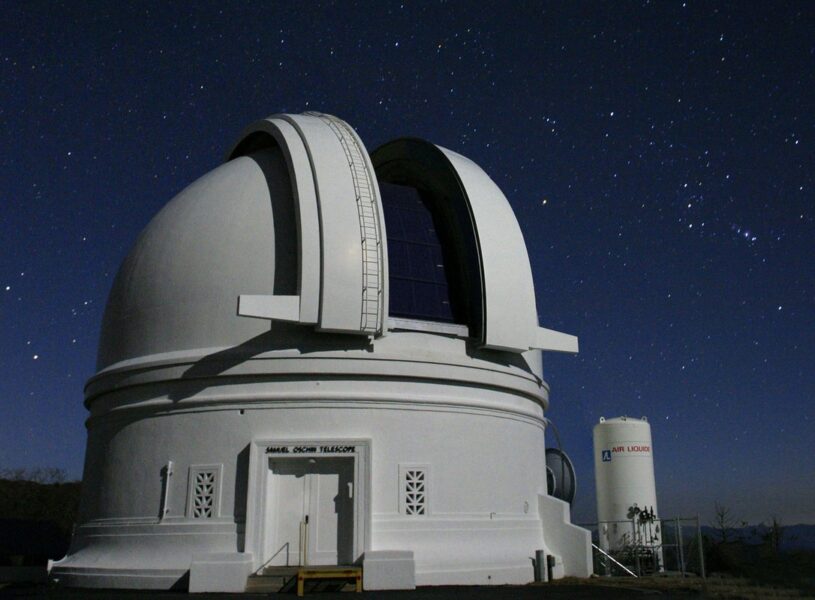
Palomar / Caltech
A tiny space rock may hint at a new population of asteroids in the inner solar system, suggests a new study in the Monthly Notices of the Royal Astronomical Society.
A team of astronomers spotted the asteroid on the night of January 4, 2020, as part of a survey of near-Sun sky using the 48-inch Samuel Oschin telescope at Palomar Observatory. The asteroid, provisionally designated 2020 AV2, was at 18th magnitude as it glided across the constellation Aquarius.
Later measurements, made after following the asteroid over several nights and during recovery later in 2021, shows it orbits entirely within Venus's orbit, traveling at most 0.65 astronomical unit from the Sun. It's reddish in color, like asteroids in the Main Belt are, and it spans 2 kilometers (1.2 miles), making it surprisingly large for its location. No other asteroids have been found with such tight orbits around the Sun.
Earlier this year, the discovery team asked the Pauma band of indigenous peoples, on whose ancestral lands the Palomar Observatory is located, to name the asteroid. Its formal name and designation is now 594913 ‘Ayló’chaxnim, (pronounced ai-LOH-chakh-nym). The name means “Venus Girl” in the group's language, Luiseño. (They initially wanted to call it Venus's Daughter to show its relation to Venus, but the resulting name was too long.)
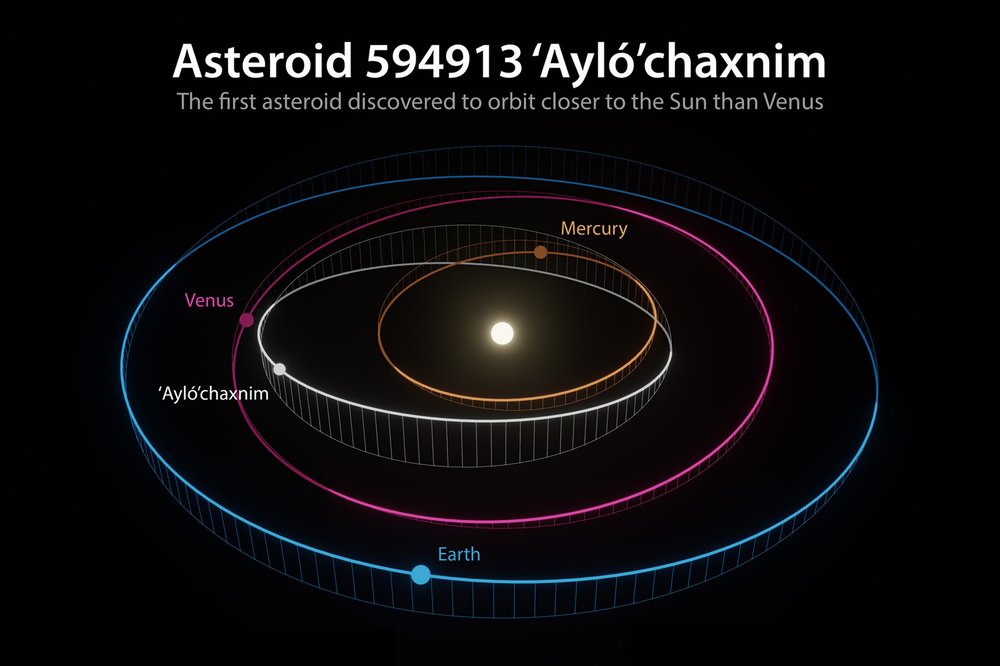
NASA / JPL / IPAC / Caltech / R. Hurt
Asteroids in the inner solar system are rare but not unheard of. Atira-class asteroids orbit entirely within Earth’s orbit. Their namesake is the first asteroid of the class, 163693 Atira, discovered in 2003. But while astronomers have long suspected other asteroids would exist inside Venus's orbit, searches turned up empty. This class of asteroids, formerly known as Vatira (with an added “V” for Venus), will now be known as Ayló’chaxnim asteroids.
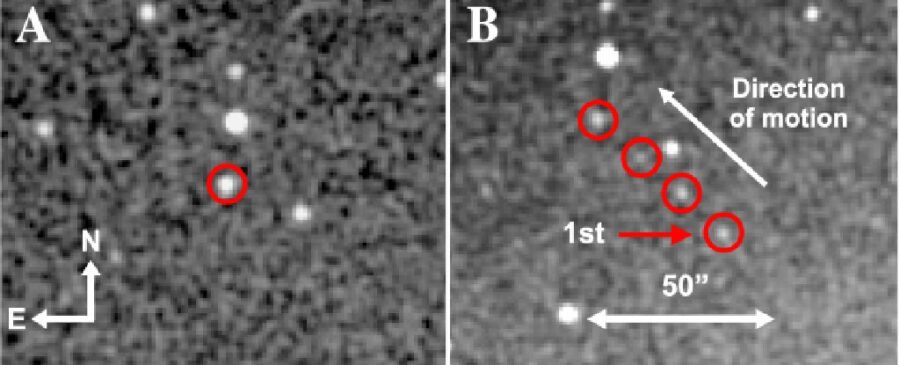
ZTF / Caltech / Bolin
Although the discovery is only the first of its kind, team member Bryce Bolin (Caltech) notes that the probability of such an early “hit” was low.
“Large asteroids in the total near-Earth object (NEO) population are rare,” says Bolin. “Only a small portion of NEOs (~0.2%) lie inside the orbit of Venus, as predicted by NEO population models.” Given the rarity of asteroids like ‘Ayló’chaxnim, either its early discovery in the group's survey was unlikely or there are more asteroids there than we thought.
Due to the asteroid's similarity to its main belt siblings, the researchers speculate that there might be a way for main belt asteroids to travel to the inner solar system.
"The current theory is that asteroids interior to Earth's and Venus's orbits migrated out of the main belt and onto orbits in the inner solar system mostly through gravitational interactions with the planets," says Robert Jedicke (University of Hawaii). Contemporary models, he adds, predict only a small fraction end up on orbits interior to Venus's and those are orbits aren't stable in the longterm. "The physical and orbital characteristics of 2022 AV2 are consistent with those models," he adds.
The team's calculations show that ‘Ayló’chaxnim is in a semi-stable orbit that has it rounding the Sun roughly three times for every two times that Venus does, which means that it's less likely to encounter Venus directly. But it's not currently in an exact 3:2 resonance, and while it may enter such a resonance in the future, it won't stay there. Sometime in the next 10 to 40 million years, a gravitational interaction with Mercury, Venus, or Earth will alter the asteroid's orbit, either directing it sunward, flinging it out of the inner solar system, or plowing it straight into a planet.
"We find asteroids throughout the solar system but there are more of them where orbits are stable over many billions of years, like the main belt and trans-Neptunian region," says Jedicke. "It's similar to how dust bunnies collect in the corners where there is less disturbance."

ZTF / Caltech / Bolin
“Searching for asteroids inside the orbit of Venus, such as ‘Ayló’chaxnim, is challenging,” says Bolin. These asteroids are never more than 45 degrees from the Sun on the sky, and most telescopes can only point so far toward the horizon. Any searches must be conducted during twilight and only for a short time. “They set shortly after twilight begins, providing only about 30 minutes per night to search for ‘Ayló’chaxnim asteroids,” Bolin explains.
The Zwicky Transient Facility's survey isn't the only telescope on the hunt. Space-based surveys, such as the proposed NEO Surveyor mission, look to cover our sunward blind spot from a different perspective. And the Vera Rubin telescope, expected to come online in 2023, will also survey the twilight sky. One could even envision a search during the brief dark periods during a total solar eclipse.
One challenge for sunward observations, though, is the increasing number of satellites, such as Starlink, that reflect sunlight in the twilight sky. ZTF astronomers have already noted an increasing contamination of twilight observations, and these satellites will affect Rubin even more. "There is motivation to start the ‘Ayló’chaxnim micro survey early in the [Rubin] observatory's operations," Bolin says, "to avoid contamination by satellites that is expected to worsen over the course of the survey."
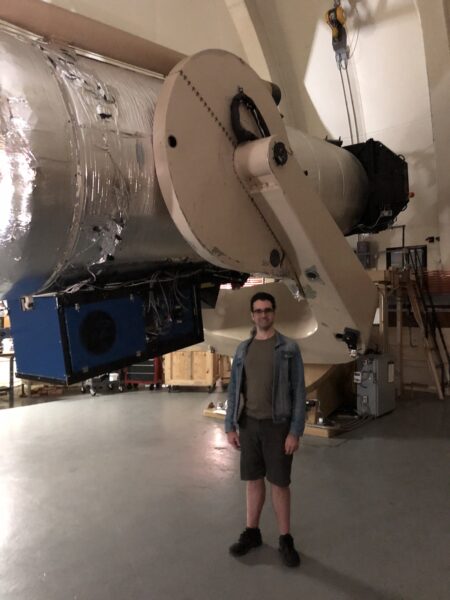
Bolin / Caltech
Sunward observations are important because they can reveal previously hidden populations. The interstellar object 1I/Oumuamua came at our planet from a sunward direction and was only discovered once it was past our orbit and headed outbound. The Chelyabinsk meteor that exploded over Chelyabinsk, Russia, in 2013 also approached Earth from the sunward direction.
"Since 2020 AV's characteristics are consistent with current theories it appears the 'tail matches the dog,' but it is important that surveys like ZTF continue pushing the asteroid discovery bounds to put better constraints on our understanding of the origin and distribution of asteroids in the inner solar system."
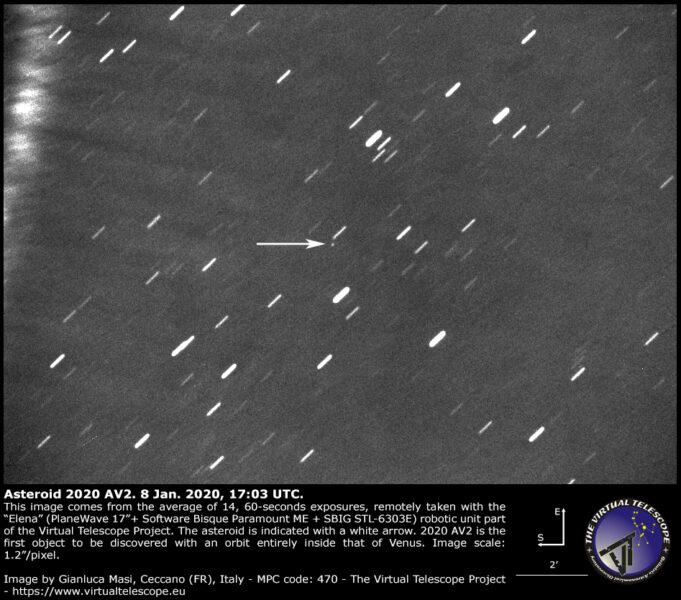
We may know the inner solar system less well than we thought. Now, the hunt is on, and it’ll be fascinating to see what future surveys may turn up.
 3
3









Comments
Anthony Barreiro
August 25, 2022 at 5:58 pm
Asteroids settle into stable orbits like dust bunnies collecting in quiet corners. I love that!
I'm also happy to see astronomers collaborating with indigenous people to name newly discovered objects. It's a small symbolic gesture of respect, and step in the right direction.
You must be logged in to post a comment.
Rod
August 29, 2022 at 11:17 am
Very interesting report. Wikipedia has a report on this asteroid providing orbital elements. https://en.wikipedia.org/wiki/594913_%EA%9E%8CAyl%C3%B3%EA%9E%8Cchaxnim
I note a = 0.554 au, e = 0.17701. I used an asteroid 1E-12 earth mass and found P = 1.5119E+02 days, perihelion = 4.5709E-01 au, aphelion = 6.5371E-01 au. My values are very close to the wiki report using Jean Meeus algorithms. In 1 Gyr period this asteroid could complete 2.4158E+09 revolutions around the Sun, if stable. All indications are that this small asteroid is not stable over Gyr periods. As wiki reports, "Nevertheless its orbit is likely to be stable for less than a million years, unless it is on (or enters soon) a nearby 3:2 mean-motion resonance with Venus, which could extend its stability to a few million years.[17][18]".
Another asteroid with a short time in our solar system, at least in its present location and orbit.
You must be logged in to post a comment.
vedo
September 3, 2022 at 9:53 pm
Immanuel Velikovsky, whose 'Worlds In Collision' was purportedly on Einstein's Princeton desk when he passed, believed that Venus itself may have been a late comer to our solar system, and had a catastrophic effect on our planet as it settled into its eventual "normal" orbit. Others, such as Christy-Vitale, postulated that a similarly sized object may have been returning to our solar vicinity periodically through the millennia, and Lemuria was one its tectonic victims.
I am barely an amateur anything, let alone an astronomer, an eclectic reader at best, yet it does appear from geological findings that something catastrophic happened around 11- 14,000 BCE, and possibly repeated to a lesser extent closer to recorded times.
You must be logged in to post a comment.
You must be logged in to post a comment.